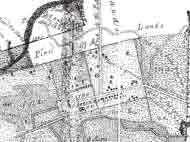Woodlands Plantation History
Palmetto Commerce Parkway passes through a portion of former Woodlands Plantation. Woodlands Plantation was a tract of land assembled by Thomas Parker by 1800. The original grants for much of the land that became Woodlands were given to Thomas Barker between 1700 and 1704. In 1716, Mrs. Sarah Barker left 600 acres to her son John Parker “wherein he now liveth.” By the early 1730s, John Parker expanded his holdings into a 1,166-acre plantation called Hayes. When Parker died in 1735, his lands were inherited by his son, John Parker II. In 1755, John Parker II purchased 146 acres of land from his neighbor Joseph Hasfort’s estate.
Most of the rice fields documented during this study were located on the old Hasfort estate. Joseph Hasfort obtained a land grant for 146 acres on 8 September 1706. When he died in 1717, he willed the land to his son, Joseph II. Joseph II’s 1748/9 inventory lists cattle, cows, horses, and colts along with plantation tools, household goods, 41 barrels of rice, three barrels of “small rice,” and 33 slaves. The same will gives “the plantation wherein I now live” to his son, Joseph III.
All of this suggests that the Hasforts built the rice fields on their tract. The number of slaves, the equipment, the rice crop, and the geography all point to construction of the fields in the first half of the 18th century. Unfortunately, Joseph III lost the land in a lawsuit and it was sold at public auction to John Parker II in 1755.
Parker incorporated Hasfort’s land into Hayes Plantation next door. In 1793 he divided his lands and gave his son John Parker III his main house and the eastern portion of the plantation. He gave the western portion of the plantation to his son Thomas. It is Thomas Parker’s property that became Woodlands and contained the early Hasfort rice fields.
Thomas Parker and his wife, Mary Drayton Parker, did not reside at Woodlands. Parker left Woodlands to Mary in 1821. She conveyed it to Edward H. Edwards in 1824. The tract passed through several owners until it was purchased at auction by land speculator James B. Gadsden in 1849. Rice production seems to have ceased prior to his ownership. Gadsden willed his large estate to his wife, Emma Georgiana Gadsden, in 1853.
Around 1884, the land came under the ownership of Albert S. Wright who sold Woodlands to Thomas Frost of Charleston. The Frost heirs sold the tract in 1908 to J. P. Clarke. During Clarke’s ownership, the City of Charleston constructed a large drainage canal that passed through both Windsor Hill and Woodlands and linked up with another old rice drain that emptied into the Goose Creek Reservoir to the north. The tract was purchased by the West Virginia Pulp and Paper Company (Westvaco) in 1937. In 1969, Westvaco conveyed the tract, along with portions of Windsor Hill to local developers. In 1983, Windsor Hill Development Company conveyed the bulk of Woodlands and parts of other tracts to members of the Collins family, the current owners.

